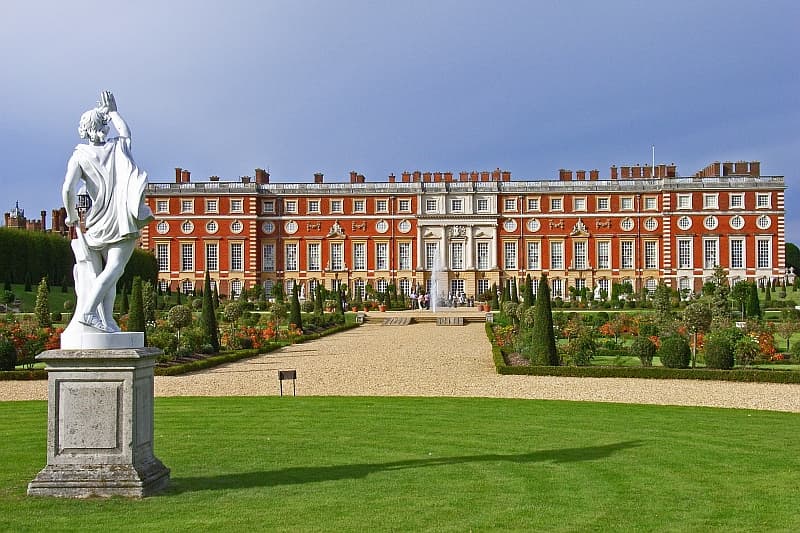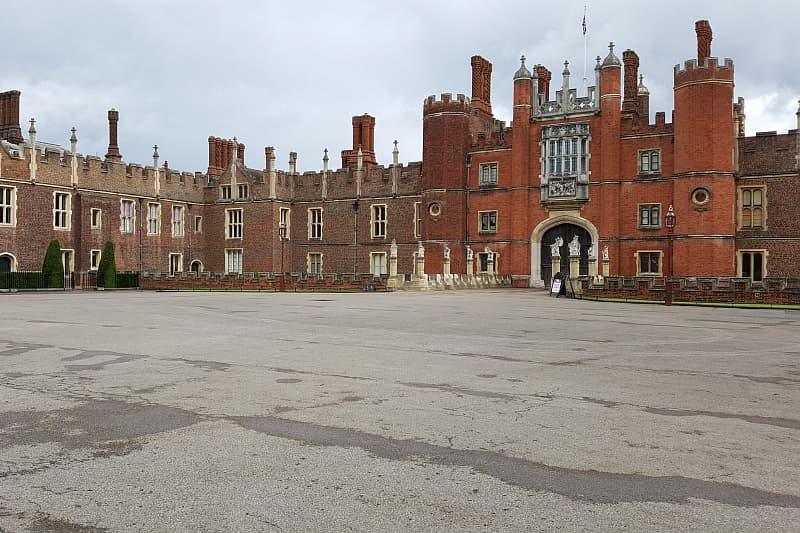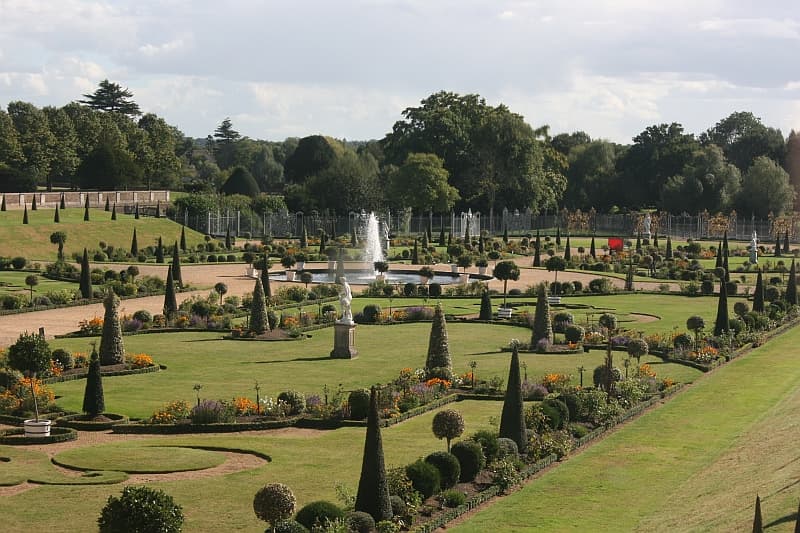From stories about the famous King Henry VIII, to extravagant baroque architecture and ceiling murals, Hampton Court Palace impresses and inspires even the most well-travelled of its visitors. Be transported from the modern day back in time to Tudor England during the 1520s, then forward to Stuart times in the 1700s. With so much to see and do, you’ll experience a wealth of stories about the occupants of the palace and absorb just some of its knowledge.
What to see at Hampton Court Palace

Henry VIII and the Tudor Palace
Built by Cardinal Thomas Wolsey in 1514, Hampton Court Palace was given to King Henry VIII after the Cardinal fell from favour in 1529. Just outside of London and surrounded by forest on all sides, the Palace was easily accessible via the Thames and provided Henry with plenty of opportunities to go hunting with his friends.
Guests to Hampton Court Palace can experience a large amount of the Tudor palace for themselves, with the Tudor Kitchens, Great Hall and State Apartments remaining intact after more than 500 years! King Henry VIII moved the court around during his reign, to be based at many different palaces, but Hampton Court was the most modern of all his residences.
The working Tudor kitchens are an incredible sight to see! State meals were prepared here, and game caught by the Royal hunting party was cooked on a giant spit, before being prepared to create a meal fit for a King. Lucky visitors might have the privilege of visiting Hampton Court Palace whilst a cooking demonstration is going on and experience the aromas of slowly roasted beef for themselves!
Tudor banquets at Hampton Court Palace were held in the grand setting of the Great Hall. Food from the kitchens was brought to courtiers, who dined at long benches that stretched the entirety of the hall. The walls of the Great Hall are insulated for warmth with expensive gold and silver-thread tapestries depicting the biblical story of Abraham. Looking up, you will see an intricate carved ceiling that is interspersed with figure heads known as ‘Eavesdroppers’. These fascinating additions to the décor served as a visual reminder to courtiers not to gossip about the King, for someone was always listening!
For the last stop on the Tudor tour, guests will walk through Hampton Court Palace’s infamous Haunted Gallery. Rumour has it that following her arrest for infidelity, Henry VIII’s fifth wife, Catherine Howard, was seized in the gallery as she tried to plead with her husband through the door of the Royal Chapel. Queen Catherine’s shrieks and screams have been heard in the gallery ever since. After her arrest, she was taken to the Tower of London and three months later was mercilessly beheaded. Will you be able to withhold a shudder as you feel the cool atmosphere that lingers with her ghost in the Haunted Gallery?

Baroque Architecture and King William III
The remarkable baroque part of Hampton Court Palace was designed in 1689 by talented British architect, Sir Christopher Wren. Modelled on the impressive display of extravagance at Versailles, Hampton Court’s baroque façade was designed to be its rival in splendour and opulence. The red brick exterior of the South front and Fountain Court is decorated with white-framed windows, porticos, and doors in pleasing mathematical symmetry.
Guests to Hampton Court Palace can also visit the wood-panelled, ceiling-painted rooms of King William III. On ascending the beautifully painted King’s staircase, guests can experience the grandeur of ‘Victory of Alexander over the Caesars’ by William’s court painter, Antonio Verrio. Designed to represent the Dutch-born William III as the protestant victor over catholic adversaries, the staircase fresco was designed to impress visitors to the court, before they were granted an audience with the King.
William III’s chambers at Hampton Court Palace are laid out in the order that visitors would have gained access to the King. Guests entering the Guard Chamber are greeted with the military might of King William III, as its walls are decorated with displays of weaponry. Moving through the following rooms, access to courtiers would have been limited. Those privileged enough were honoured with entrance to the presence, eating and privy chambers. As you move through the state rooms, the decorative beauty of each room increases, peaking in grandeur at the Great Bedchamber. This elaborately decorated room with four-poster bed and painted ceiling was reserved for only the most exclusive members of the King’s entourage.
King William III’s private rooms are much smaller and more compact. Guests can move through the intimate wood-panelled spaces, which feel warmer and less public than the larger state rooms. Affectionately nicknamed the ‘closets’, the rooms now display beautiful paintings from the Royal Collection and items that Willliam III prized amongst his favourite possessions. His magnificent Dining Chamber is adorned with Sir Godfrey Kneller’s ‘Hampton Court Beauties’ and is laid out as it was in William’s day, giving us an idea of his taste.

King George II, Queen Caroline and the Georgian Apartments
In spring and summer months, guests to Hampton Court Palace can enjoy the glamour of the Georgian Apartments. Entering up the Queen’s staircase, visitors can stand beneath William Kent’s eighteenth-century architecture and a ceiling that was commissioned by King George II and his wife, Queen Caroline of Ansbach.
Moving from room to room, you will see Hampton Court Palace’s most opulent rooms, from the Dining Room, Drawing Room, State Bedchamber and Gallery. The rooms are adorned with beautiful paintings by old master painters like Paul Peter Rubens, exquisite furniture and ceramics by the very best craftspeople and glittering rock crystal Chandeliers. Don’t forget to pause for a moment to admire the breath-taking view from the Drawing Room, which looks onto topiary-yew-tree-lined paths and a great fountain in the grounds.
Queen Caroline’s private apartments are also on display at Hampton Court Palace. These rooms are much smaller and warmer than the Queen’s State rooms. Displaying personal items like cosmetics, a bath and paintings to her tastes, the rooms are a rich colour of red silk. Find yourself transposed into an ethereal oratory before you exit the apartments, as you take in the sounds of heavenly angels to views of wood-panelled walls and Renaissance triptychs.
The suite of rooms created at Hampton Court Palace during this period for the Duke of Cumberland have now been transformed into an art gallery. Art lovers can see works by Rembrandt, Caravaggio, Canaletto, and Van Dyck; most of which are on loan from the Royal Collection.

The Royal Chapel
The Royal Chapel is Hampton Court Palace’s most majestic feature. Now exhibiting a combination of architectural styles, it showcases a stunning ceiling, wood-panelled altar screen and striking organ.
The Royal Pew can be visited from the Tudor side of the palace and overlooks the beautifully painted ornate ceiling presenting a royal blue background punctuated with gold stars. The inscription on the vaults of the ceiling reads ‘Dieu et Mon Droit’. This royal motto was coined by Henry VIII and translates as ‘God and my right’, symbolising the role of an English monarch as head of the Church of England.
The Royal Pew at Hampton Court Palace also contains a replica version of King Henry VIII’s crown. This reproduction crown is made with real emeralds, rubies, and other precious stones, giving visitors an insight into how tremendous it would have been in Tudor times.

The Landscaped Gardens and Hampton Court Palace Maze
With a magnificent maze, formal baroque gardens and the oldest and largest grapevine in the world, Hampton Court Palace’s gardens are not to be missed! Explore 750 acres of formal gardens, with views of the River Thames, the Long Water, trimmed topiary and walled gardens.
Visitors shouldn’t miss an opportunity to stroll through the perfectly laid out baroque garden on the south side of the Palace, where summer indulges you in spectacles of sun-kissed citrus trees. Can you spot the areas used for filming some of your favourite films and series, such as Bridgerton?

Cruise the Thames Aboard Magna Carta
Glide effortlessly up the River Thames on hotel barge Magna Carta to see stunning views of Hampton Court Palace from a different perspective. Enjoy observing the baroque façade and landscaped gardens from the water and cruise past William III’s Banqueting House, near Hampton Court Bridge.
For more information on our classic England cruise, and the rest of our collection of luxury hotel barge cruises, why not order a free copy of our brochure or speak to a member of our team directly using our handy Contact Form.
Hampton Court Q&A
Do any royals still live at Hampton Court?
Hampton Court Palace is not currently inhabited by any royals and has been vacant since George II was the last King to live there, leaving in 1737. Hampton Court Palace opened to the public as a tourist attraction in 1838, during Queen Victoria’s reign.
Where is Hampton Court Palace?
Situated in East Molesey in the London Borough of Richmond-on-Thames, Hampton Court Palace is a part of Greater London. Hampton Court Palace was previously classified as a part of the county of Surrey, and once occupied a woodland landscape, which was part of the Royal Parks.
Who lives at Hampton Court Palace?
No one currently lives within Hampton Court Palace itself, but in 1737, the palace was turned into apartments for ‘Grace and Favour’ tenants. Many former employees and courtiers who had served the royal family were offered accommodation at the palace from 1737 until the twentieth century. The last Grace and Favour resident died in 2022.
Who owns Hampton Court Palace?
Hampton Court Palace is owned by the crown and currently belongs to King Charles III. The Palace is taken care of by a trust, known as Historic Royal Palaces, who are responsible for its upkeep. Hampton Court Palace is opened to the public as a tourist attraction.
When was Hampton Court Palace built?
Built from 1515 to 1521, Hampton Court Palace was built in the Tudor era and features a red brick gatehouse and two large courtyards. Only part of the original palace still exists, including some of Henry VIII’s apartments, the Great Hall, and the Kitchens.
Who built Hampton Court Palace?
Hampton Court Palace was commissioned by Cardinal Thomas Wolsey who was the Archbishop of York and advisor to King Henry VIII. In 1528 when Cardinal Wolsey fell out of favour with Henry VIII, he gifted Hampton Court to the King.
Who lived in Hampton Court Palace?
Hampton Court Palace is known for being the home of the English King, Henry VIII, and he lived there with all six of his wives. Other notable royal residents were Queen Mary II and William III, George I and George II, who each left their own mark on the architecture and design of the Palace.
Is Hampton Court Palace worth seeing?
A fusion of Tudor, Baroque and Georgian architecture, Hampton Court Palace is a stunning attraction. Just a 30-minute train ride from central London, the palace is set within beautifully landscaped grounds, near Bushy Park. Visitors can stop-by to see the best bits or spend an entire day wandering its elegant rooms and spectacular gardens.
Is it free to walk around Hampton Court Palace?
Visitors to Hampton Court Palace will need to purchase a ticket to go around the palace and its gardens. A walk down the drive is free if you’re looking for a photo opportunity in front of the red-brick gatehouse, or you can enjoy views of the building from Hampton Court bridge and the River Thames.
What is Hampton Court Palace known for?
Having been King Henry VIII’s favourite residence, Hampton Court Palace has many famous features. Visitors can explore the maze, see the oldest and largest grape vine in England, and experience the palace’s working Tudor kitchens.
 English
English
 Spanish
Spanish French
French German
German Norwegian
Norwegian Portuguese
Portuguese Swedish
Swedish Italian
Italian Russian
Russian Simplified Chinese
Simplified Chinese Japanese
Japanese